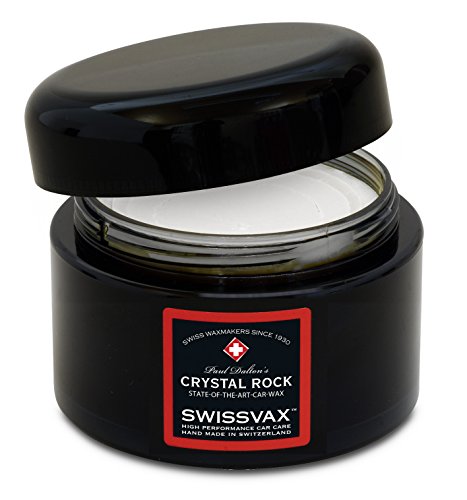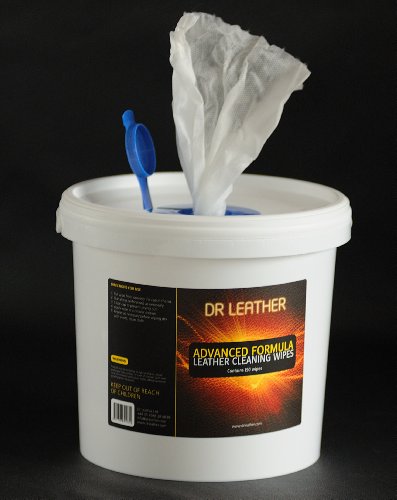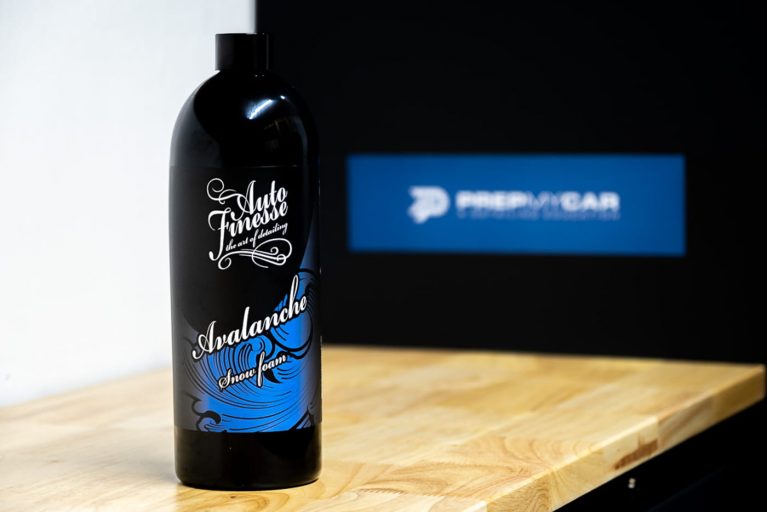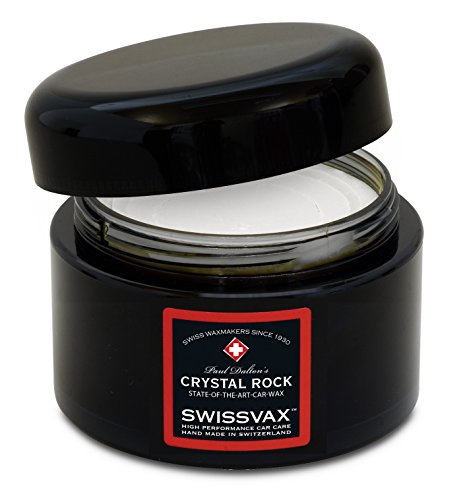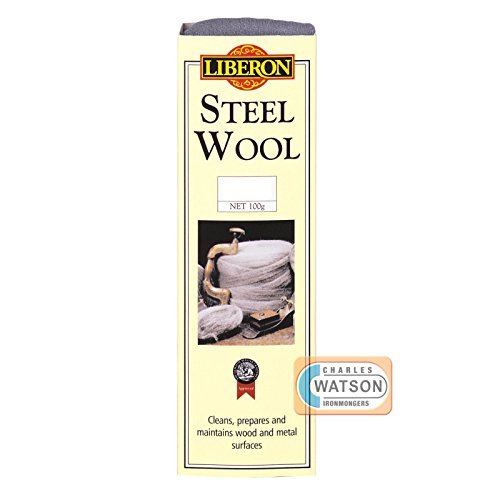Best Way to Dry a Car
The drying phase of car detailing is often one of the most dangerous. Few people aware of the best way to dry a car and as a result, can inflict masses of damage to their cars paint.
Of course, it is important to wash the car properly in order to avoid paint damage. But applying the proper drying techniques will ensure a smooth, glossy, and scratch-free finish.
The Importance of Drying a Car
You’ll notice that after washing the car you will see a lot of small water beads sitting on top of your paint. Those seemingly small and innocuous beads of water are the primary causes of water spots or water marks.
Now, those water marks may look like harmless traces of dried-on residue. But in truth, the miniscule traces of hard minerals in the water have dug themselves deep into the clear coat, which is emphasised by sun or heat exposure.
While water beading is a good sign (it means a wax is protecting the surface), allowing the water beads to dry out without wiping down or removing the water will inevitably spell disaster, and I’m not even talking about aesthetics here. The presence of water spots on shiny paint are ghastly!
But the best way to dry a car is not simply a matter of wiping down exposed surfaces with a cotton rag. Like I said at the beginning of this article, the drying phase is a critical part of the detailing process. It is during this time that it is terribly easy to introduce a host of hairline scratches and swirls in the finish. This will be magnified if you have a black or dark-coloured vehicle.
How NOT to Dry Your Car
In order to prevent inflicting scratches and swirl marks over the paint surface, there are a couple of things you need to keep in mind and points that I want to make before getting on to safely drying your car.
- Avoid using water blades or squeegees to remove standing water on the paint. Water blades will only push and shove the water over the surface. If there are tiny amounts of free-standing dirt and debris on the water beads, then moving them over the clear coat will leave scratches or unsightly marring.

- Do not use a leather chamois. Similar to a water blade, a leather chamois will only push the water away instead of absorbing the liquid. Even synthetic chamois are only designed to absorb water. The material is not intended to absorb dirt. What this means is the dirt and contaminants will move across the surface of the clear coat and cause scratches as you wipe the surface. This will especially hold true if you have a newer car or dark-coloured vehicle with pristine paint.

- Avoid washing and drying the vehicle in direct sunlight or if the surfaces are hot to the touch. Hot surfaces will enhance the evaporation process, which in turn will cause water spots. Always wash and dry your vehicle in a cool and shaded area, preferably inside a garage if you can.
- Do not apply excessive force when wiping down the vehicle. Many people think that elbow grease is the key to quickly dry the vehicle. On the contrary, the trick is to treat the process gently instead of applying manly force. Remember the goal here is to effectively dry the car without inducing scratches and swirls. The more you make contact with the paint, the more chances of scratching the finish.
- Make sure all surfaces are properly rinsed with clean water. Professional detailers will most often conduct a final rinse using de-ionized water. Now I don’t want to sound like a bespectacled boffin here, but de-ionized water is simply tap water but without the metals and minerals in the liquid content.
If you have a de-ionizing kit at home, you can use it to totally eliminate the chances of developing water spots after washing your car. But whether you have access to a de-ionized water or not, always make sure the surface is free from traces of soap before drying the vehicle.
If you can afford it as part of your detailing budget, a de-ionizer is going to be one of the best investments that you can make. They remove all particles from your water and will eliminate marks from water spots.
The Best Ways to Dry a Car
So, in order to truly achieve a glossy and scratch-free finish, I will discuss the best ways to dry a car. Please take note that even if you don’t have access to expensive machines like a leaf blower or de-ionizer kit, you can still dry your vehicle safely using nothing but a set of microfiber towels.
The Professional Method
Step 1:
Wash the vehicle thoroughly. Rinse well with plain water or de-ionized water. I prefer using de-ionized water or distilled water in the rinsing process. It simply makes the job of drying the vehicle a bit faster than with plain tap water. Distilled water dries faster than hard water. The best part? De-ionized water will NOT leave behind spots or marks as the water dries up.
Step 2:
Grab the leaf blower or metro-vac to gently blast off standing water over the vehicle. Using a blowing machine will make it easier to dry the vehicle.
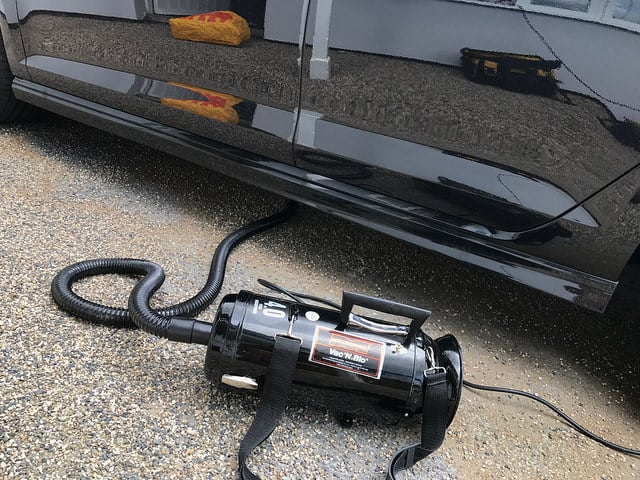
Try to concentrate the pressurized air on those nooks and crannies that accumulate water such as the window sills, door sills, headlights, taillights, badges, and grille. Applying this method will significantly reduce your drying time.
Step 3:
The final step is to wipe the surfaces gently using drying aids. Products such as quick detailers or detailing sprays are great in achieving a concours-quality finish after washing the car. Some quick detailers are formulated with carnauba wax and will effectively leave an additional layer of wax over the paint.
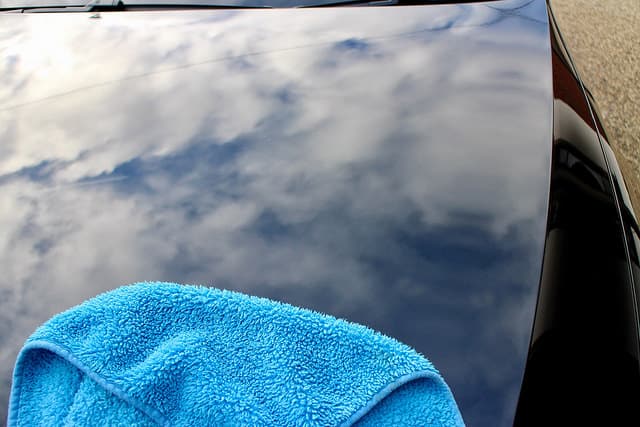
But my primary reason for using detailing spray is the lubrication. Grab the microfiber towel and apply two or three sprays of the quick detailer on the cloth. Lightly mist the paint surface with the detailer and wipe the surface gently. The detailer will provide the required lubrication to prevent scratches as you wipe the surface.
Here’s a tip you need to remember: thicker microfiber drying towels will work best when lightly moist. If you don’t have a detailing spray, simply dunk the towel in a bucket of clean or distilled water and wring out the excess liquid. Always dry the vehicle using a lightly moist microfiber towel. They simply work better in lifting off dust, dirt, and liquid when slightly wet!
The Microfiber Technique
You can still dry a car effectively without using de-ionized water and blowing machines. Heck, you can even dry a vehicle without using a detailing spray! The technique is to use the right kind of microfiber towel for the job.
However, there are many types of microfiber towels in the market. Let’s discuss this first before proceeding to the manual method of drying a car.
When purchasing microfiber towels, you need to remember two things: the density and the blend ratioof the towel.
Best Microfiber drying towel:
- ULTRA PREMIUM 70/30 Blend 420gsm Tagless Professional Microfiber Towel With Over 360,000 Fibers Per Square Inch and Totally Paint-Safe Silky Soft…
- PERFECT CHOICE: Waterless Washing, Quick Detailing, Wax, Compound, Sealant, Glaze, and Polish Removal; Polishing Chrome and Other Shiny Metals;…
- DUAL-PILE CONSTRUCTION: One Side with Longer Fibers to Remove Loose Particles and for Buffing, and a Shorter Knap, Tighter Terry Weave Side to Remove…
The density is expressed in GSM or grams per square inch. A microfiber towel with a higher density will be softer, thicker and plusher. The best microfiber towels for drying cars are those with a higher 600 or 800 GSM density for obvious reasons. Thicker and fluffier towels can lift off more dirt and absorb more liquid.
Let’s proceed to the blend ratio. All microfiber towels are manufactured by blending two fibers: polyester and polyamide. If the microfiber towel has a blend ratio of 60/40, it means a 60 percent blend of polyester and 40 percent polyamide.
So what does this mean? The absorbency and texture of microfiber is mainly determined by the ratio of polyamide. This means a towel with 60/40 will be thicker and more absorbent than a microfiber towel with an 80/20 blend ration.
Summing it all up, the best microfiber towel for drying cars is one with a high density and high ratio of polyamide. Keep these things in mind when purchasing microfiber towels for your vehicle.
Without further ado, here are the steps to dry a car.
Step 1:
Wash the vehicle and rinse well with clean water.
Step 2:
In this next step, you can use a detailing spray if you have one. If you do, lightly mist the microfiber towel and the drying surface before proceeding. Give it a couple of quick sprays and wipe the surface gently.
But if you’re not using a detailing spray, it is best to lightly mist the towel with water and wring out the excess. Now, lay the towel over a section of the vehicle and pull one end of the towel gently across the surface. This method will allow the towel to absorb as much of the liquid without applying excessive pressure on the surface.
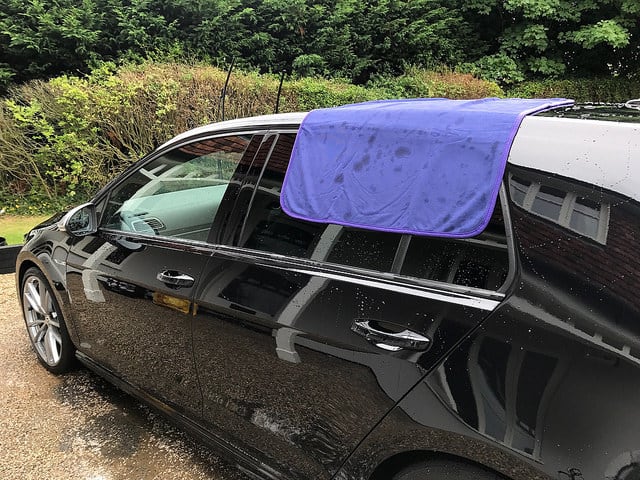
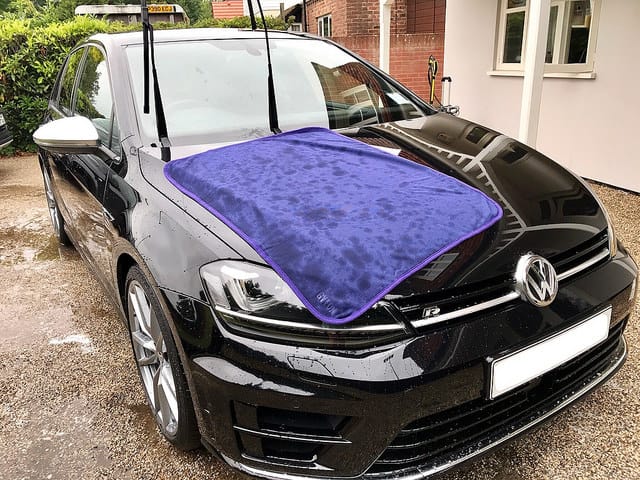
Another method is the pat-and-dry technique. Simply fold the towel diagonally, lay it over the wet surface, and pat the towel lightly using your hands. After the liquid is absorbed, gently lift of the towel and wring out when necessary.
Whichever method you choose, the golden rule is NOT to apply excessive force when wiping the surface. Treat the surface gently to reap maximum rewards.
Step 3:
Step back and admire your work.
How do I wash my microfiber towels?
For lightly soiled microfiber towels, the best way to clean them is to hand wash with warm water. Do not use hot water, laundry detergent, dish soap, and fabric softeners to wash microfiber towels. Doing so will only lead to accelerated wear and tear of the material.
But for soiled or dirty microfiber, it is best to soak the towels in warm water and a concentrated microfiber cleaner. Microfiber cleaners have a unique formula that contains higher solutions of surfactants and emulsifiers. The cleaner is formulated to effectively dissolve dirt and oils without harming the fibers in the material.
Of course, you can throw the towels in the washing machine. The important thing to remember is to use warm water and an extra rinse cycle. Again, if you need to use detergent, it is always best to use a dedicated microfiber cleaner.
After washing, the towels should be hanged and air dried. Tumble drying is also an option as long as the machine is set to the lowest and gentlest setting. This actually works well for new towels as well as the tumble dryer tends to remove any loose particles.
Do quick detailers or drying aids work?
Yes, but they’re not necessary. It all depends on the level of perfection you’re looking for or the condition of the vehicle. Drying aids will help to lubricate the surface as the microfiber towel absorbs the liquid. This means lesser chances of scratching or swirling the paint.
In some cases, drying aids will further lubricate the surface of the paint by applying a thin layer of wax as you dry the vehicle. However, some products have a tendency of leaving residue or white marks. Whichever product you’re using, always read the directions in the bottle before proceeding.



